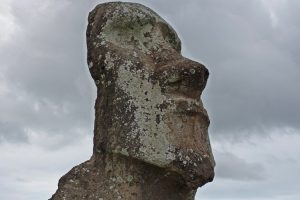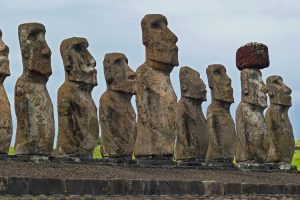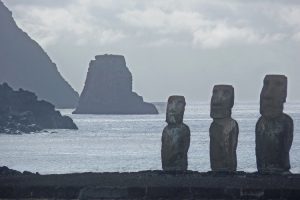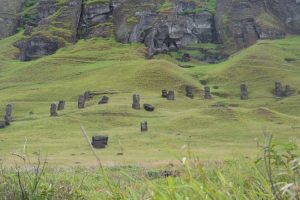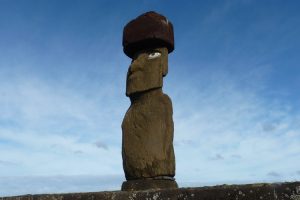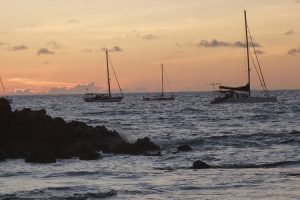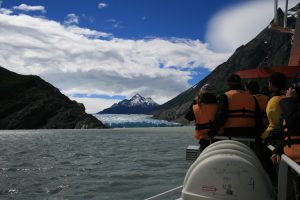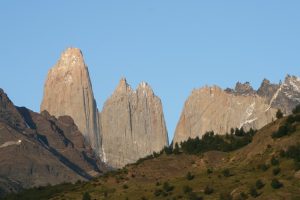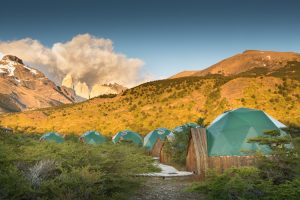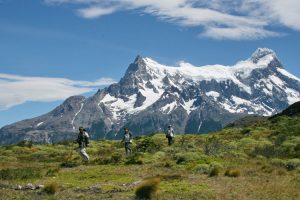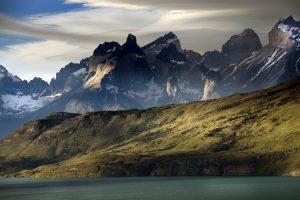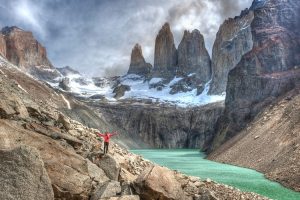Chile, Chilean Patagonia | Walking & Trekking

- Grade:
- ?
Moderate
- Duration: 17 days from the UK
- Walks on: 7 days
- Private Departures Available
Flight inclusive from £7830, Land only from £6795
Walk amidst the spectacular rock pinnacles of the Torres del Paine National Park and the mysterious landscapes of Easter Island.
Highlights
- View the giant moai statues of Easter Island
- Walk to the top of the three main extinct volcanoes that comprise Easter Island
- Visit the quarries where the giant statues were made
- Stay in a geodesic dome at the award winning EcoCamp in the heart of Torres Del Paine National Park
- Enjoy walks and boat rides for close up views of the highlights of the Torres del Paine
- Take a guided tour of Chileâs laid back capital of Santiago
Reviews
This superb holiday gives you the opportunity to combine two stunning regions - the amazing landscapes of the Torres del Paine where granite pillars soar vertically more than 2,000m above the Patagonia steppe, and the enigmatic landscapes and statues of Easter Island.
You begin the trip by flying into Chile's modern, lively capital City of Santiago where you take a guided tour. You then fly to Punta Arenas and transfer to a camp in the heart of the Torres del Paine National Park where you spend three days enjoying a range of walks and boat trips that showcase the classic scenery of the park - glaciers, rushing rios, granite towers, snow-clad summits and turquoise lakes abound. Your accommodation in Torres del Paine is in the striking geodesic domes of the Eco Camp, a truly unique and very comfortable experience that will make you feel at one with the beautiful Patagonian scenery. Before leaving Patagonia you also have time to explore Punta Arenas, the largest city in Southern Patagonia with many interesting buildings and museums.
As you fly out of Punta Arenas and back to Santiago, part one of your exciting adventure is complete. It's now time to embark on part two as you make the long flight west, far across the Pacific Ocean, to remote Easter Island. Whereas, most visitors to Easter Island only stay for a couple of days - just enough to photograph the main Moai sites - you will have almost six full days to undertake a really in-depth exploration of the island. Starting with a walking tour of the attractive harbourside town of Hanga Roa, you then head deep into the island, visiting many extraordinary Moai sites as well as the quarry where the statues were originally carved. You will also enjoy walks to lava-tube caves, volcanoes and an abandoned crater-rim village as well as a good long hike along the island’s rugged northern coastline. Throughout, you will be accompanied by an expert guide who will give you a real insight into the fascinating history and geology of the island as well as the intriguing mysteries of the giant Moai heads and the Rapa Nui people. Along with your guided walks and excursions you‘ll also have free time to relax at your attractive waterfront hotel or try out some of the locally available activities such as horse riding, cycling or scuba diving.
Finally you fly back to Santiago with time to reflect on your thrilling adventure discovering two of the world’s most beautiful and remarkable places.
Private Departures
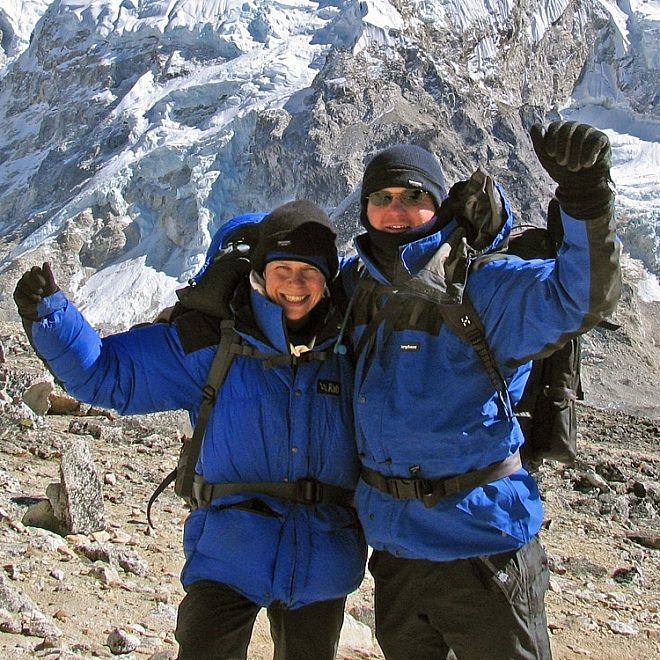
Easter Island & Patagonia - Private Departures
If you would prefer to travel just with your partner, friends or family, we can arrange a private departure of this holiday. You follow the same itinerary, but travel on dates that suit you. Alternatively we can include elements of this holiday in a bespoke Tailor Made itinerary. Contact our friendly team for details and prices, and to make a booking.
At a glance
Moderate
Duration: 17 days from the UK
Walks on: 7 days
Max. Altitude: Max altitude 900m/2,952ft, Patagonia
Private Departures Available
Guaranteed to run for a minimum of 5 clients
Maximum group size: 12
Accommodation types: Hotels, Eco Camp
Meal arrangements: Bed and Breakfast in Santiago. While in the Torres del Paine, breakfasts, lunches and most dinners are included. On Easter Island all breakfasts and lunches are included. (14 x breakfasts, 11 x lunches, 3 x dinners). For evening meals on Easter Island, there are very many excellent restaurants in Hanga Roa to choose from.
Itinerary overview
| Day | Activity |
|---|---|
| 1-2 | Fly to Santiago. Afternoon city tour. |
| 3 | Fly to Punta Arenas. |
| 4 | Drive to National Park. Walk Fauna Trail. |
| 5-6 | Choice of activities at Eco Camp. |
| 7-8 | Drive to Punta Arenas. City tour and fly to Santiago. |
| 9 | Fly to Easter Island. Walking tour of town and visit Tahai Ahu. |
| 10 | Full day tour of island. |
| 11-14 | Walks including Rano Kau, Aku Akivi, Poike and the northern coast. |
| 15-17 | Fly to Santiago. Fly to London. |
Leader: Local Leaders, Easter Island & Chile
In both Easter Island and Chile, we use expert, English-speaking local guides who have an intimate knowledge of the area and an infectious passion for nature. They are all very hard-working, attentive and helpful.
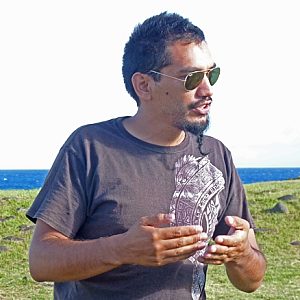
Holiday Itinerary
Day 1 - Fly London to Santiago.
Depart London on an overnight flight to Santiago.

Day 2 - Arrive Santiago. Afternoon city tour.
Today you arrive in Santiago where you will be met and transferred to your hotel for a rest and freshen up. You will then have a briefing from your guide. In the afternoon there will be a city tour which begins with you being picked-up from the hotel and taken downtown to Mercado Central. This well-renowned market, popular with locals and tourists alike, supplies many Santiago homes and businesses with fresh fish all year round. Next to the market is Plaza de Armas, Santiago’s main square and kilometre zero, the point from which all distances in the country are measured. Famous architecture in the square includes the Metropolitan cathedral and the central post office, originally built as a house for Spanish conqueror Pedro de Valdivia. Close by stands the Justice Tribunal, in a neo-classical building housing the Supreme Court and ex-Congress.
From here you walk towards the Alameda, the main street of the city centre, via the busy pedestrian walkway Paseo Ahumada. This walkway is famous for its crowds, shops, and diversity of people. Once you reach the Alameda you walk a couple of blocks west to the Presidential palace, La Moneda. The palace, a model of 18th century colonial architecture, is one of Santiago’s most recognisable landmarks and a symbol of Chile’s political past and its famously turbulent history.
Next you climb Cerro Santa Lucía, where Santiago was founded in 1541 by Pedro Valdivia. From the top of the hill there is a great 360° panoramic view of Santiago. Your tour finishes by visiting the bohemian Lastarria neighbourhood, lined with cafés, restaurants, small theatres, bookstores and boutique shops. Afterwards you will be driven to your hotel.

Day 3 - Fly to Punta Arenas – 3½ hours. Drive to Puerto Natales – 250 km, 3 hours. Free time.
This morning you will be transferred to the airport for your flight to Punta Arenas. On arrival, you will be met by your guide who who will give a quick briefing before the journey to Puerto Natales. The drive takes you through the scenic Patagonian landscape before arriving in Puerto Natales, a town located on the edge of Last Hope Sound. The rest of the day is free to explore this picturesque town which was originally inhabited by the Kawésqar or Alacaluf people and the Aoniken or Tehuelche people. The first European to discover the city was Juan Ladrillero, a sailor who was looking for the Strait of Magellan in 1557, but no Europeans settled here until the late 19th century when the German explorer Hermann Eberhard established a sheep station. The town is now the main base for excursions to the Torres del Paine National Park, one of the most popular parks in Chile. Catering well for its many visitors there are plenty of excellent cafes and restaurants to try, seafood being a speciality.

Day 4 - Drive to the National Park - 2 ½ hours. Walk on the ‘fauna trail’. View petroglyphs.
Today starts with a drive to the EcoCamp Patagonia, your home for the next 3 nights, located in the heart of the Torres del Paine National Park. The journey takes you through amazing scenery with wild and wonderful landscapes to gaze at and plenty of birds and mammals to be seen. The landscape of the park is dominated by the Paine massif, which is an eastern spur of the Andes located on the east side of the Grey Glacier, rising dramatically above the Patagonian steppe. Four small valleys separate the spectacular granite spires and mountains of the massif.
Arriving in the park you will hike along the so called Fauna Trail. Walking northwards you will see some of the park's fauna including guanacos (cousins to the alpaca and llama) who graze the open steppes where its main natural enemy the puma cannot hunt it undetected. Guanacos are considered to be the park's conservation success. After over a decade of protection from hunters and poachers the population has increased and they can now be admired all over the park. There are also likely to be ostrich like nandus, foxes and maybe, if lucky, even the occasional puma print. You will also see some prehistoric cave paintings. Passing Goic lagoon you will reach Laguna Amarga Ranger Station where your transport will meet you and transfer you back to the EcoCamp, nestled in the heart of the park with views of the Torres. This will be your first night in this award winning sustainable lodge where you can enjoy being in close proximity to nature.

Day 5 - Choice of activities from EcoCamp.
While you are at the EcoCamp there will be a daily choice of excursions organised for their guests which you may join. Each day there are several options available which will include a selection of walks to the key sights of the park such as the Towers of Paine or Glacier Grey. There may also be the option to do an organised bike ride or boat trip. The walks and excursions change daily.

Day 6 - Choice of activities from EcoCamp.
As yesterday there will be a selection of walks and activities at the EcoCamp for you to choose from today.

Day 7 - Drive back to Punta Arenas – 6 hours. Free time.
After an early breakfast you will board the bus for the return drive back to Punta Arenas. After arriving in the town you will have the rest of the day free to relax and explore the city. Set at the foot of the Andes on the western side of the Strait of Magellan, Punta Arenas is considered to be Patagonia’s most interesting city featuring many mansions and other impressive buildings dating from the late 19th/early 20th century wool boom. There are plenty of sights and museums to explore and numerous cafes and restaurants to relax in and watch the world go by.

Day 8 - Morning city tour and visit to Nao Victoria Museum. Afternoon fly to Santiago.
In the morning you will be driven the short distance to the Nao Victoria museum created as a life-size replica of the vessel, Nao Victoria, built for and commanded by Ferdinand Magellan when he set sail to conquer the world back in 1519. The replica vessel has been built with original plans to create an interactive and dynamic museum that enables you to re-live the discovery of the Strait of Magellan and to imagine what it was like to be part of a sixteenth-century sailing experience when America and Patagonia in particular, was still uncharted.
Returning to the city you can try a local restaurant for your lunch before the transfer to the airport and flight back to Santiago.

Day 9 - Fly to Easter Island. Museum visit and guided walking tour of Hanga Roa town. Visit Tahai Ahu.
Today starts with a short transfer to Santiago airport for the 5 hour 10 minute flight to Easter Island. Taking off there are good views of the Andes and their foothills stretching out to the coast. Excitement builds as you approach the island which you overfly and then turn back to drop slowly on one of the longest runways in the world. It was built and the length increased by the Americans to act as an emergency landing site for the space shuttle. Already you will notice a relaxed laid back atmosphere as you walk through the large low airport building. Drive the short distance to hotel O'Tai for your first briefing and a welcome lunch.
In the afternoon you will drive to the museum for a guided tour followed by a walking tour of the town including the cemetery, church and other places of interest. The town of Hanga Roa really feels like a south sea island. It is very green with lots of tropical plants, flowers, palm trees and wide roads with low buildings. There are shops, cafes, restaurants, the harbour where you will find the dive centres, and the Catholic Church which sits at the top of the town. Anchored off the harbour are usually a few yachts whose owners must have sailed across the Pacific to get there! The town contains many fine wooden carvings and it is interesting to note that the bird man symbol is incorporated into many of the figures (you will hear more about the bird man culture on your 3rd day on Easter Island).
You will then get into your minibus and drive the short distance to Aku Tahai where you will see your first proper Moai and begin to hear something of their history and some of the theories. Firstly, it is thought that they were erected in a form of ancestor worship and having been brought from the quarries all the way over to their final resting place they were then erected on the stone platforms called ahus. The main construction probably started around 1,100 or 1,200 AD and building probably continued into the 1600's when it is thought that warfare broke out between the various tribes. Probably the various tribes knocked each other's statues over. It is thought that the statues were built on their ahus facing inland and facing the villages that they were supposed to protect. The Rapa Nui people felt that the power of their ancestors resided in these statues and therefore protected their individual villages.
In any event at Aku Tahai the fallen statues have been re-erected, by the American archaeologist William Mulloy between 1968 and 1970, and you will see that one has been given eyes. Apparently many of the statues did indeed have eyes and this was not known for a long time. 18 sets of eyes were found and others have been identified in museums around the world. The eyes were designed just to sit in the eye sockets. They were made of coral and the centre made of the same red stone as the statues hats.
You will return to Hangaroa where your guide will be able to suggest a restaurant for dinner.

Day 10 - A full day tour to include Tahai Ahu, Vaihu, Rano Raraku quarry, Pito Kura and Anakena beach.
After the first of many great breakfasts at your hotel you will drive to Vahai which is about 10 km from Hangaroa and is a classic example of an ahu where all the statues have been knocked over and have been left as they were. You can see some of the hats that have rolled off the fallen statues and lie scattered around. The hats are made from a completely different stone, reddish in colour, and much lighter than the statues themselves. It was therefore easier for them to put the hats on top of the erected statues, although quite how they did this is still debated.
Next you move on to one of the highlights of the Island - the main quarry where the statues were carved. This is called Rano Raraku. Here there are dozens of finished statues already on their way towards their resting places but left abandoned when conflict broke out on the island. There are also dozens and dozens of statues in various stages of carving in the rock face itself. The quarry is located in the south east end of the island and it is from here that there are a whole series of “roads” that criss cross the island, and which must have been used to transport the statues to their ahus.
There are something like 400 moai in various stages of development. It is all a very strange sight, particularly because most of the statues that had started their journeys have sunk deep into the ground so that only the heads are left visible. You might wonder how the statues were carved when there was no metal on the island and the answer to this apparently is that chisels and hammers were made from a much harder obsidian rock found elsewhere on the island. The much softer volcanic tuff rock that the statues are made of were therefore carved with the flints made from shards of obsidian.
Some of the largest statues on the island are here at Rano Raraku. There is in fact the largest moai on the island at the highest part of the walking route. It is 21m long and the head alone is 7m. It is estimated to weigh more than 200 tons. There will be plenty of time to hear lots of the amazing stories from the guide and wander around the site and look at the ranger station at the foot of the quarry. You will then have a picnic at Rano Raraku quarry.
From Rano Raraku you now move on to Pito Kura. This site has the largest Moai ever transported from Rana Raraku and erected on a platform. The Moai is almost 10m tall and now lies face down with its top knot next to it. On this site there is another mystery. There is a very large round stone almost like an egg which is magnetised. Place a compass near it and the needle goes crazy. The legend is that the first king of the island Hotu Matua brought it with him from Polynesia. Apparently there are other magnetised stones in other parts of the island.
Lastly, you proceed to Anakena beach which is some 18km from Hanga Roa. This is Easter Island’s main beach, an absolutely idyllic place fringed with palm trees and the perfect spot to hang out at the end of a fascinating day.

Day 11 - Trek to Rano Kau Crater, 384m/1,260ft, and continue to Orongo village. Afternoon at leisure.
It is a short drive to Ana Kaitangata. This literally means “man eating cave” and certainly there are legends about cannibalism on the island. The roof of the cave has some very interesting paintings. You will then start the walk up to the crater of Rano Kau and following that the village of Orongo. The path you are following is called Arao Te Ao (the path of power). This starts at the top of the cliff above the cave and leads you through eucalyptus trees and past the National Park office (CONAF). Here they are doing lots of useful work on re-forestation. After about 45minutes you come to the end of the eucalyptus trees and looking back can see the runway. You now walk up slowly through lush vegetation to the view point of Mirador Rano Kao. It takes between an hour and an hour and a half to reach the view point. Looking down into the crater it is almost circular and the circumference of the crater is some 1,650m. At the bottom of the crater is a lake/swamp where rainwater collects and vegetation grows and floats on the water. The original settlers apparently planted oranges, apples, taro, yam, sweet potato, and wild grapes on the banks of the crater. In fact the grapes may have come with the first Catholic priests. There are also medicinal plants grown at the bottom. The height at the top of the rim is some 384m/1,260ft above sea level.
Having admired the incredible view you then walk along the rim of the crater to visit Orongo village. This occupies a precarious position on the top of the crater rim with 300m cliffs plunging down into the Pacific on one side and the steep slope dropping into the crater on the other. It is thought that Orongo was never occupied as a permanent place of residence but rather was used only for ceremonies. Eventually a cult emerged here in the late 17th century called Tangata Manu (bird man) which worshiped the Make-Make God. This new religion, which superseded the old ancestor worship, was based on the bird man competition. Each year the chiefs of the island either took part themselves or sent their best warriors to take part in the bird man competition. If you now look out to sea you will see the 3 islands of Motu Kao-Kao, Motu Iti and Motu Nui. The latter is the largest island and it was here that the Easter Island seagull appeared every year to lay its eggs. The object of the competition was to descend the dangerous cliffs and swim to the island and wait there until the first eggs had been laid. An egg then had to be carried while the contestant swam back, climbed the cliff and delivered the first unbroken egg to the king, who was waiting at the village of Orongo.
There are 53 houses which were largely reconstructed in 1974 by the archaeologist William Malloy and a group of islanders. Because of its location there were no Moai here. However it was from here that in 1868 the crew of the English ship Topaze took the famous Moai called Hoa Hakananai’a which is currently on display in the British Museum in London. It is in fact 2.5m high and unlike most of the Moai was carved out of basalt. On its back are carved figures representing the bird man and its rituals. In fact in many places on the island there are bird man figures carved onto the rocks. Your guide may well show you some of these as you explore Easter Island. Look out for the birthing stone, which is very interesting, in the village.
After this you visit the fascinating Orongo visitor centre and have a picnic lunch on the edge of the crater. You will then return by car from the visitor centre to the hotel. After this the afternoon is free to “do your own thing” and perhaps explore a bit more of the town of Hanga Roa.

Day 12 - Drive to Vaitea. Walk to Terevaka, 511m/1,676ft. Descend to Ahu Akivi. Return to town. Lunch and afternoon at leisure.
Today you will drive to Vaitea, formerly a settlement of the English sheep company Williamson Balfour who operated their business, growing sheep and sending the hides to the Chilean continent, on Rapa Nui.
You will start your walk up to the summit of the extinct volcano of Maunga Terevaka from here. You first walk through a forested area until you come out into the wide open slopes leading to the summit of Maunga Terevaka. On the way you visit the actual crater of the volcano and a Hibiscus cave. Having reached the summit of Terevaka, you are now standing on the highest point of the island at 511m/1,676ft, and from here you have a full 360 degree view of the island. It is very interesting to be able to see the other two main volcanoes situated on the western and eastern points of the island's triangle and in addition to appreciate about 75 secondary volcanic cones that cover the island.
The Ahu of Akivi is unusual because it is one of the few platforms which were build inland with its statues looking out to the west towards the setting sun. The statues and platform were restored by American archaeologist William Molloy and the Chilean Gonzalo Figueroa between 1960 and 1961. The statues are of a very similar style and it is thought that they may have been carved around the same time. Your guide may tell you the fantastic and amazing oral tradition of the priest Haumaka who lived on an island named Hiva, somewhere in French Polinesia, supposedly related to the Marquesas. He had a dream that because of the situation at Hiva it might be necessary to send embarcations to another island. He convinced his king to send 7 explorers in a boat laden with provisions to find Rapa Nui and prepare it for him and his people. Having found the island they planted crops and trees and then returned to Hiva in order to bring Hotu Matua together with his sister Avareipua with their people to their new home. The oral tradition tells us that the 7 Moais at Akivi represent the 7 explorers who first landed on Rapa Nui.
Returning to town lunch will be provided in a local restaurant. The afternoon is free time.

Day 13 - Visit Tongariki. Trek to Poike, 410m/1,345ft.
Fewer people visit this end of the island but the walk is very interesting. There are some fascinating sites and even more amazing legends.
First though you take the bus to visit Tongariki. This is the largest and most impressive Ahu on the island with 15 standing statues. Each Moai is very different and it is thought that they represented specific individual ancestors. The restoration work carried out between 1993 and 1996 was based on drawings made by the famous British archaeologist, Katherine Routledge who spent 17 months on the island in 1914. She and her husband commissioned the building of a special sailing boat and then sailed all the way to Easter Island from the UK. Incidentally it is well worth reading of her adventures in her book “The Mystery of Easter Island”.
It is a short drive from Tongariki turning right onto a rough road to reach a single house from where you start the trek. It is quite hard work walking to the top of the volcano through long grasses and takes about an hour and a half to reach the summit at a height of 410m/1,345ft. Here there is a crater choked with trees and on the rim an aerial and a solar panel. From the summit you now descend to 2 further volcanic cones Maungu Teatea, and Maungu Parehe. Just below the summit of Poike is a Moai which is said to be one of the oldest on the island, thought perhaps to date from 800 AD. There are carvings on the rocks of the first volcanic cone, including a large head whose open mouth was used to collect rainwater. Just below the 3rd volcanic cone is the edge of some very precipitous cliffs. Thor Hyerdahl explored some of the caves in the cliffs by abseiling down. Here there is another very old head next to a substantial Ahu. These smaller volcanic cones are made from a white coloured rock which was used to make the only female Moai. There are thoughts that there may have been 10 female Moai as there were 10 queens in the early part of their history. One is in the museum, one is buried (for protection against the elements) and one is at Vinapu.
You will now cross a pass between the 2 smaller volcanic cones and return to the bus by walking along an old 4 x 4 track.
Poike was the territory of the Long Ear people and legend has it that this was where they were all killed in a battle with the Short Ears. Apparently they had built a ditch across the “neck” of the island, filled it with wood and set fire to it. However, the Short Ears crossed at the other end unseen by the Long Ears, climbed Poike and fell upon the warriors below who they then threw into the burning ditch, all except one man who was allowed to live. Poike is the oldest volcano on the island at 10 million years old.

Day 14 - Trek the northern coastline.
All the day walks that you have done to this point will have been good preparation for the long hike along the northern coastline. This can be 6-7 hours or 7-8 hours depending on how many things you stop to look at! Don’t forget to take plenty of drinking water as it can be a long hot day and there is no water to be had on the way.
The minibus will take you out to Ahu Tepeeu. It is located 8km from Hangaroa and was at some point a large village. There has been no restoration and very few visitors make the effort to go but it is a good place to learn something of the agricultural way of life of the original inhabitants. For instance there are several manavais – stone circles in which crops were grown to protect them from the elements. You will also see the remains of some elliptical houseboat dwellings. Original village houses were built in the shape of upturned boats, and in many of the places you visit along the coast you will see the clear stone foundations of these houses. The foundation stones are set in the ground with drilled holes. Branches were then inserted into the holes, bent over, and laced together and thatched. Your trek starts from Ahu Tepeu and after 20 minutes you come to an unnamed Ahu where there is a burial chamber and more circular agricultural enclosures. Occasionally you will see lying on the ground shards of obsidian that they used as cutting tools. Look out for hollowed stones – used for collecting water. Ten minutes beyond here there is a conical border marker called a Pipi Horeko. Often it was forbidden to cross such a border and the ancestors spirits (or Aku Aku) might kill somebody for such a transgression. Beyond here there is another Ahu which shows a burial tomb inside. After about an hour from the start of the trek you come to some large rocks and small caves, from here you can see the main town in the distance. Your guide may show you the round stone towers that people built to watch the stars. There is a small tunnel hole at the bottom of the towers that you could crawl though and then lie on your back to watch the stars through the top of the tower.
You will see in parts of the walk areas where there are many caves and throughout the day you will come across ancient Ahu all with fallen Moai. Some of them are built right on the edge of cliffs and the foundation stones are very reminiscent indeed of Inca workmanship. In some places you will walk up what must have been the roads that bought the Moai to the villages. Today you will see lots of ‘wild horses’. They are owned by locals but roam free. There are lots of hawks on the island and other interesting bird life.
After about 2 hours you come to a boat house next to an Ahu, next to a cave, next to a dry stream bed. 10 minutes later you arrive at a cairn on a big pile of rocks where the path is well defined. After 3 hours from the start you come to a solitary eucalyptus tree by the path. Descend from here a steep long slope to a flattish area with some fantastic boat houses (4 or 5 of them), an Ahu with fallen statues, a chicken house in the shape of a big boat and a huge burial chamber that is perfectly built with a separate entrance.
Half an hour on from here there is a cave with petroglyphs, Hanga Omohi. By now you are turning the corner of the coastline and after another 15 minutes you come to 3 or 4 Ahu like burial tombs and another Tupa tower for looking at stars. After about 6-7 hours you come to a lone palm tree and soon after that there is a track to follow with views of Anakena beach in the distance. After a long and exciting walk you reach Anakena Beach where you will have time to relax before returning to town.

Day 15 - Fly to Santiago - 5 hours.
With great sadness and with perhaps the forlorn hope that you might return one day it is time to leave the island. With so much information and so many theories that you have absorbed you will undoubtedly want to read more on the subject in years to come. When you get back to the UK you might wonder whether it all really did happen or whether it was a dream.
You now transfer for the 5 hour flight back to Santiago. Rest of the day free to do as you please.

Day 16 - Fly to London.
After breakfast you transfer to the airport for your overnight flight back to London.

Day 17 - Arrive London.
Today you will arrive back in the UK.
Map
Map Key
-
 Airport
Airport
-
 Point of interest
Point of interest
-
 Mountain Peak
Mountain Peak
-
 Day walk in this area
Day walk in this area
-
 Flights
Flights
-
 Internal Transfers
Internal Transfers
-
 Trek
Trek
Loading...
Hold your place
Not quite ready to book? Why not call us on +44 (0) 1453 844400 to hold a no obligation place while you make up your mind?
No Surcharge Guarantee
No surcharges will be applied to your holiday after you book. Prices on this website are updated regularly. The Flight Inclusive holiday price, or Land Only holiday price, will be confirmed to you at the time you make your booking. There will be no surcharges after your booking has been confirmed.
Flight inclusive holidays
The 'flight inclusive' holiday prices shown on this website are based upon our preferred airlines and the best priced economy class fares we are able to secure at the time of publication.
We will be able to advise on fares with alternative airlines, upgrades to Business Class, and the options for flights from regional UK airports, please contact us for more details.
Booking your holiday
-
Deposit
From £950.00
For the majority of our holidays, a deposit payment of £400.00 per person is required to secure your place(s), however a small number of holidays require a higher deposit - please refer to the holiday itinerary for more details. If the holiday departs within 60 days, a deposit of £1,000.00 per person is required.
Book now!
- Book your small group holiday securely online – click the ‘Book’ button next to your chosen departure or visit our How to Book page
- Complete and return a Booking Form available to download here.
- Call us on +44 (0)1453 844400 and one of our travel specialists will talk you through the booking process.
What’s included
- Local English-speaking guides in Chile, plus knowledgeable English-speaking guides on Easter Island
- Economy class return airfares from the UK including flights to Easter Island and any internal flights
- Single, timed, group airport transfers for international flights on arrival and departure
- All other transfers as per the itinerary
- All road transport by private vehicles
- Good standard accommodation in Santiago, Puerto Natales, Punta Arenas and Easter Island on a twin share basis
- Three nights EcoCamp accommodation in the Torres del Paine - standard domes, twin share
- 14 breakfasts, 11 lunches and 3 dinners
- Sightseeing and activities as specified with a choice of activities at EcoCamp
- Entry fees to national parks
- Carbon offsetting with the Ecoan Tree Planting Project (for clients taking our flight inclusive option)
- The option of joining one of our pre-trip meets in the Cotswolds
- A free Mountain Kingdoms Water-to-Go bottle
What’s not included
- Travel insurance
- Visa fees
- Dinners in Santiago, Punta Natales, Punta Arenas and on Easter Island. 2 x lunches in Santiago.
- Optional trips and activities
- Tips


